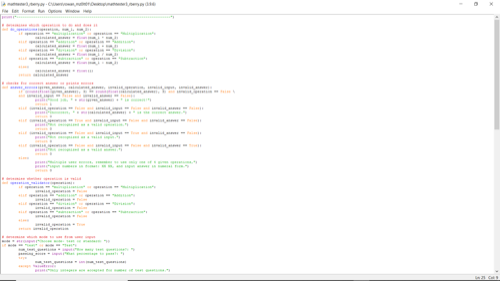This semester and class began with learning Python. With a combination of CodeHS assignments and small weekly projects, I tested my coding abilities and created several simple programs, such as a mathematics tester.





After completing that final coding project, I moved on to Arduino, a simple computer that allowed me to make circuits with wires, resistors, LEDs, and the like, while applying code to these circuits to achieve desired effects-- a motor spinning, lights flickering in a pattern, etc. There were 10 modules in a manual, each showing an example circuit with example code of what could be done with a physical component or circuit-building principle.

Having completed this, with a better understanding now of how computer coding worked from Python and how it related to the physical device from Arduino, I continued forward to Raspberry Pi. Raspberry Pi, a small but complete computer running its own version of Linux/Debian, is great for learning to command a computer with code. The first thing I did was learn basic console commands and how to use Network tools on Mac computers, before digitally installing a virtual version of a Raspberry Pi computer on my laptop. This allowed me to do almost everything one could do with a physical Raspberry PI, but with everything on my own familiar device.

Following a manual Master Raspberry Pi, I began to read about all the possible uses and applications of Raspberry Pi and followed along with tutorials on how to perform these functions-- from changing the login password to hosting a web server.
As I kept going with this manual for several weeks, the class decided we would make our final project a sort of scavenger hunt / puzzle, wherein each of us would apply skills we learned (we split into several small groups that worked on different things after completing the Arduino examples) to create a fun challenge for our classmates to attempt. In the interest of keeping things fair for both of the 2 teams, we placed students into pairings based on what they learned and gave each team one student. As a result, I did not make my segment of the puzzle Raspberry PI based, but with a music DAW called Logic Pro.

I learned how to use Logic Pro to a basic extent, and then made my puzzle, incorporating some musical tone matching and identification, as well as some morse code.
After doing the scavenger hunt / puzzle, I am pleased that my team won. I myself made no significant contribution to solving most of the puzzles, except for perhaps the final music one. While I was able to make the scrambled audio almost sound like words, it was another team member that truly solved the final puzzle by rapidly clicking on the track until menus appeared and it fixed itself. The opposing team was unable to solve my puzzle; I explained it after we won. While it was never intended to be so challenging, I suppose the added difficulty was good for my team in the end. With this project done, the last thing I shall do in this class is make a portfolio of all I've accomplished in it.
Comments